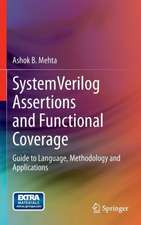CTL for Test Information of Digital ICs
Autor Rohit Kapuren Limba Engleză Paperback – 26 apr 2013
CTL for Test Information of Digital ICS is an example-oriented book on CTL that is written with the goal of getting the reader to think like the creators of CTL. Most of the explanations are limited to very simple examples so that the netlist (design) can be drawn out for better visualization of the concepts.
There are two types of example CTL syntax in this book. Examples that explain the use of CTL and examples that describe syntax and semantics of the language as it is being introduced.
This book should be read by anyone who is interested in testing integrated circuits. The contents of this book are especially relevant to the segment of the industry that is developing cores and/or using cores in system-on-chip methodologies.
| Toate formatele și edițiile | Preț | Express |
|---|---|---|
| Paperback (1) | 635.15 lei 6-8 săpt. | |
| Springer Us – 26 apr 2013 | 635.15 lei 6-8 săpt. | |
| Hardback (1) | 641.20 lei 6-8 săpt. | |
| Springer Us – 31 oct 2002 | 641.20 lei 6-8 săpt. |
Preț: 635.15 lei
Preț vechi: 747.23 lei
-15% Nou
Puncte Express: 953
Preț estimativ în valută:
121.54€ • 125.58$ • 101.11£
121.54€ • 125.58$ • 101.11£
Carte tipărită la comandă
Livrare economică 20 martie-03 aprilie
Preluare comenzi: 021 569.72.76
Specificații
ISBN-13: 9781475778007
ISBN-10: 1475778007
Pagini: 188
Ilustrații: XI, 173 p.
Dimensiuni: 155 x 235 x 10 mm
Greutate: 0.27 kg
Ediția:Softcover reprint of the original 1st ed. 2003
Editura: Springer Us
Colecția Springer
Locul publicării:New York, NY, United States
ISBN-10: 1475778007
Pagini: 188
Ilustrații: XI, 173 p.
Dimensiuni: 155 x 235 x 10 mm
Greutate: 0.27 kg
Ediția:Softcover reprint of the original 1st ed. 2003
Editura: Springer Us
Colecția Springer
Locul publicării:New York, NY, United States
Public țintă
ResearchCuprins
Hello CTL.- Uses of CTL.- Design Philosophy of CTL.- Simplified View of CTL.- CTL Syntax and Semantics: Design Entities.- CTL Syntax and Semantics: Top Level View.- CTL Syntax and Semantics: Test Mode Constructs in the Environment.- CTL Syntax and Semantics: Shortcuts.- Examples Describing Test Information in CTL.
Recenzii
From the reviews:
"The book is a welcome addition to the literature. It is definitely useful as a reference for anyone who is interested in creating test programs for SoC designs. This book promises to make a valuable contribution to the education of graduate students in electrical and computer engineering, and a very useful addition to the library of the maturer investigator in SoC designs or related fields."
(Microelectronics Reliability, 43 (2003)
"CTL for test information of Digital ICs will have significant impact and will be accessible to anyone who is interested in testing integrated circuits. The contents of this book are especially relevant to the segment of the industry that is developing cores and/or using cores in system-on-chip methodologies. The author has done an excellent job. It is a pleasure to read and consult a book that tries to promote understanding, not just coverage. Indeed a stimulating book … ." (Current Engineering Practice, Vol. 47, 2002-2003)
"The book is a welcome addition to the literature. It is definitely useful as a reference for anyone who is interested in creating test programs for SoC designs. This book promises to make a valuable contribution to the education of graduate students in electrical and computer engineering, and a very useful addition to the library of the maturer investigator in SoC designs or related fields."
(Microelectronics Reliability, 43 (2003)
"CTL for test information of Digital ICs will have significant impact and will be accessible to anyone who is interested in testing integrated circuits. The contents of this book are especially relevant to the segment of the industry that is developing cores and/or using cores in system-on-chip methodologies. The author has done an excellent job. It is a pleasure to read and consult a book that tries to promote understanding, not just coverage. Indeed a stimulating book … ." (Current Engineering Practice, Vol. 47, 2002-2003)
















